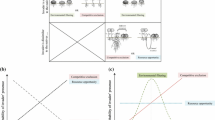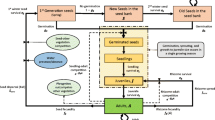Abstract
As the number of biological invasions increases, interactions between different invasive species will become increasingly important. Several studies have examined facilitative invader–invader interactions, potentially leading to invasional meltdown. However, if invader interactions are negative, invasional interference may lead to lower invader abundance and spread. To explore this possibility, we develop models of two competing invaders. A landscape simulation model examines the patterns created by two such species invading into the same region. We then apply the model to a case study of Carduus nutans L. and C. acanthoides L., two economically important invasive weeds that exhibit a spatially segregated distribution in central Pennsylvania, USA. The results of these spatially-explicit models are generally consistent with the results of classic Lotka–Volterra competition models, with widespread coexistence predicted if interspecific effects are weaker than intraspecific effects for both species. However, spatial segregation of the two species (with lower net densities and no further spread) may arise, particularly when interspecific competition is stronger than intraspecific competition. A moving area of overlap may result when one species is a superior competitor. In the Carduus system, our model suggests that invasional interference will lead to lower levels of each species when together, but a similar net level of thistle invasion due to the similarity of intra- and interspecific competition. Thus, invasional interference may have important implications for the distribution and management of invasive species.





Similar content being viewed by others
References
Allen MR, Shea K (2006) Spatial segregation of congeneric invaders in central Pennsylvania, USA. Biol Invasions 8:509–521
Amarasekare P (2003) Competitive coexistence in spatially structured environments: a synthesis. Ecol Lett 6:1109–1122
Ballari SA, Kuebbing SE, Nuñez MA (2016) Potential problems of removing one invasive species at a time: interactions between invasive vertebrates and unexpected effects of removal programs. Peer J 4:e2029
Bullock JM, Edwards RJ, Carey PD, Rose RJ (2000) Geographical separation of two Ulex species at three spatial scales: does competition limit species’ ranges? Ecography 23:257–271
Burlakova LE, Tulumello BL, Karatayev AY, Krebs RA, Schloesser DW, Paterson WL, Griffith TA, Scott MW, Crail T, Zanatta DT (2014) Competitive replacement of invasive congeners may relax impact on native species: interactions among zebra, quagga, and native unionid mussels. PLoS One 9:e114926
Case TJ (2000) An illustrated guide to theoretical ecology. Oxford University Press, New York
Chesson P (2000) Mechanisms of maintenance of species diversity. Annu Rev Ecol Syst 31:343–366
Connolly J, Wayne P, Bazzaz FA (2001) Interspecific competition in plants: how well do current methods answer fundamental questions? Am Nat 157:107–125
Coomes DA, Rees M, Turnbull L (1999) Identifying aggregation and association in fully mapped spatial data. Ecology 80:554–565
Desrochers AM, Bain JF, Warwick SI (1988) The biology of Canadian weeds 89. Carduus nutans L. and Carduus acanthoides L. Can J Plant Sci 68:1053–1068
Gómez S, Gonda-King L, Orians CM, Preisser EL (2014) Competitor avoidance drives within-host feeding site selection in a passively dispersed herbivore. Ecol Entomol 39:10–16
Gómez S, Gonda-King L, Orians CM, Orwig DA, Panko R, Radville L, Soltis N, Thornber CS, Preisser EL (2015) Interactions between invasive herbivores and their longterm impact on New England hemlock forests. Biol Invasions 17:661–673
Gurevitch J, Fox GA, Wardle GM, Inderjit, Taub D (2011) Emergent insights from the synthesis of conceptual frameworks for biological invasions. Ecol Lett 14:407–418
Henriksson A, Wardle DA, Trygg J, Diehl S, Englund G (2016) Strong invaders are strong defenders – implications for the resistance of invaded communities. Ecol Lett 19:487–494
Hutchinson GE (1957) Concluding remarks. Cold Spring Harb Symp Quant Biol 22:415–427
Jackson MC (2015) Interactions among multiple invasive animals. Ecology 96:2035–2041
Jongejans E, Shea K, Skarpaas O, Kelly D, Sheppard AW, Woodburn TL (2008) Dispersal and demography contributions to population spread of Carduus nutans in its native and invaded range. J Ecol 96:687–697
Juliano SA (2010) Coexistence, exclusion, or neutrality? A meta-analysis of competition between and resident mosquitoes. Isr J Ecol Evol 56:325–351
Kendall BE (2015) Some directions in ecological theory. Ecology 96:3117–3125
Kuebbing SE, Nuñez MA (2015) Negative, neutral, and positive interactions among nonnative plants: Patterns, processes, and management implications. Glob Chang Biol 21:926–934
Kuebbing SE, Nuñez MA, Simberloff D (2013) Current mismatch between research and conservation efforts: the need to study co-occurring invasive plant species. Biol Conserv 160:121–129
Levine JM, Adler PB, Yelenik SG (2004) A meta-analysis of biotic resistance to exotic plant invasions. Ecol Lett 7:975–989
Lotka AJ (1924) Elements of physical biology. Dover, New York
MacArthur R, Levins R (1967) Limiting similarity convergence and divergence of coexisting species. Am Nat 101:377–385
Neuhauser C, Pacala SW (1999) An explicitly spatial version of the Lotka–Volterra model with interspecific competition. Ann Appl Probab 9:1226–1259
Pacala SW (1986) Neighborhood models of plant-population dynamics 2. multispecies models of annuals. Theor Popul Biol 29:262–292
Pacala SW, Silander JA (1985) Neighborhood models of plant-population dynamics 0.1. single-species models of annuals. Am Nat 125:385–411
Rauschert ESJ, Shea K (2012) Invasional interference due to similar inter- and intraspecific competition between invaders may affect management. Ecol Appl 22:1413–1420
Rauschert ESJ, Shea K, Bjornstad ON (2012) Coexistence patterns of two invasive thistle species, Carduus nutans and C. acanthoides, at three spatial scales. Biol Invasions 14:151–164
Ruokolainen L, Hanski I (2016) Stable coexistence of ecologically identical species: conspecific aggregation via reproductive interference. J Anim Ecol 85:1365–2656
Russell JC, Sataruddin NS, Heard AD (2014) Over-invasion by functionally equivalent invasive species. Ecology 95:2268–2276
Seabloom EW, Bjørnstad ON, Bolker BM, Reichman OJ (2005) Spatial signature of environmental heterogeneity, dispersal, and competition in successional grasslands. Ecol Monogr 75:199–214
Shea K, Chesson P (2002) Community ecology theory as a framework for biological invasions. Trends Ecol Evol 17:170–176
Shea K, Kelly D, Sheppard AW, Woodburn TL (2005) Context-dependent biological control of an invasive thistle. Ecology 86:3174–3181
Silvertown J, Holtier S, Johnson J, Dale P (1992) Cellular automaton models of interspecific competition for space—the effect of pattern on process. J Ecol 80:527–534
Simberloff D (2006) Invasional meltdown 6 years later: important phenomenon, unfortunate metaphor, or both? Ecol Lett 9:912–919
Simberloff D, Von Holle B (1999) Positive interactions of nonindigenous species: invasional meltdown? Biol Invasions 1:21–32
Skarpaas O, Shea K (2007) Dispersal patterns, dispersal mechanisms, and invasion wave speeds for invasive thistles. Am Nat 170:421–430
Tilman D (1994) Competition and biodiversity in spatially structured habitats. Ecology 75:2–16
Vitousek PM, Mooney HA, Lubchenco J, Melillo JM (1997) Human domination of Earth’s ecosystems. Science 277:494–499
Wang JH, Kropff MJ, Lammert B, Christensen S, Hansen PK (2003) Using CA model to obtain insight into mechanism of plant population spread in a controllable system: annual weeds as an example. Ecol Modell 166:277–286
Warwick SI, Thompson BK, Black LD (1990) Comparative growth response in Carduus nutans, Carduus acanthoides, and their F1 hybrids. Can J Bot 68:1675–1679
Weiner J, Conte PT (1981) Dispersal and neighborhood effects in an annual plant competition model. Ecol Model 13:131–147
Yang SA, Ferrari MJ, Shea K (2011) Pollinator behavior mediates negative interactions between two congeneric invasive plant species. Am Nat 177:110–118
Acknowledgements
This work was supported by the United States Department of Agriculture Cooperative State Research, Education, and Extension Service National Research Initiative (Biology of Weedy and Invasive Plants) Grant #2002-35320-1228 to KS and a National Aeronautics and Space Administration Space Grant Fellowship to ER. Thanks to Olav Skarpaas, Zeynep Sezen, Adam Miller and Ingmar Rauschert for helpful suggestions.
Author information
Authors and Affiliations
Corresponding author
Rights and permissions
About this article
Cite this article
Rauschert, E.S.J., Shea, K. Competition between similar invasive species: modeling invasional interference across a landscape. Popul Ecol 59, 79–88 (2017). https://doi.org/10.1007/s10144-016-0569-7
Received:
Accepted:
Published:
Issue Date:
DOI: https://doi.org/10.1007/s10144-016-0569-7




